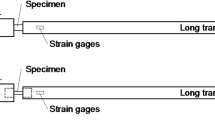Abstract
A photographic system using a light-emitting diode (LED) illuminator and a 35-mm rotating drum camera has been developed for the diagnosis of dynamic-tensile tests conducted with a split Hopkinson tension bar. Back-lit photographs of deforming tensile samples are obtained at rates up to 50 kHz. The LED exposures are precisely time correlated with the conventional bar-strain-gage records. The system can be used to extend the measurement of stress-strain curves beyond the onset of plastic instability (necking).
Similar content being viewed by others
References
Nicholas, T., “Tensile Testing of Materials at High Rates of Strain”,Experimental Mechanics,21,177–185 (1980).
Bridgeman, P.W., Studies in Large Plastic Flow and Fracture, Chapt. 1, McGraw-Hill, New York (1952).
Hutchings, I.M. and Andrews, D.R., “Light Emitting Diodes as Short Duration Light Sources” Proc. 13th Int. Cong. High Speed Photography, Tokyo, 222–225 (1978).
Author information
Authors and Affiliations
Rights and permissions
About this article
Cite this article
Cross, L.A., Bless, S.J., Rajendran, A.M. et al. New technique to investigate necking in a tensile hopkinson bar. Experimental Mechanics 24, 184–186 (1984). https://doi.org/10.1007/BF02323163
Received:
Revised:
Issue Date:
DOI: https://doi.org/10.1007/BF02323163




